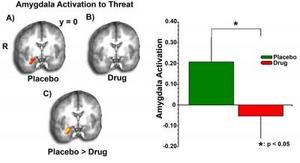Right now, about half of all people who take medicine for an anxiety disorder don't get much help from it. And doctors have no definitive way to predict who will, and who won't, benefit from each anti-anxiety prescription they write.
But a University of Michigan Medical School researcher and his team are working to bring more certainty to how doctors and patients choose anxiety treatments, by probing the connection between brain activity, genetics and medication.
In a paper last month in the
Journal of Neuroscience, K. Luan Phan, M.D., and his former University of Chicago colleagues reported intriguing findings from a brain imaging study in occasional, non-dependent, marijuana users.

|
| ©K. Luan Phan, M.D.
|
| These brain scans and graph show that response to a threat was greatly reduced when study volunteers received THC, compared with placebo. This indicates that the brain's cannabinoid system may be a good target for anxiety disorder treatments.
|
Comment: Instead of looking into the core problems that cause millions of Americans to suffer from anxiety disorders, millions are invested in creating new and advanced drugs, while it is clear that the only ones who are going to benefit from are pharmaceutical companies.